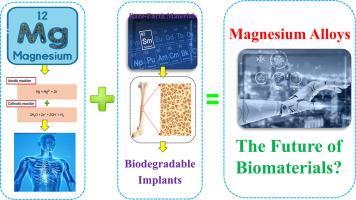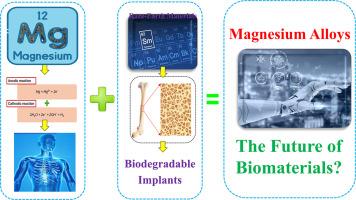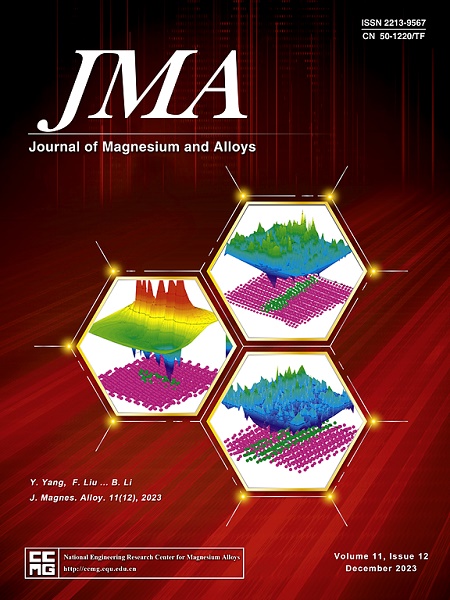Rare-Earth based magnesium alloys as a potential biomaterial for the future
IF 15.8
1区 材料科学
Q1 METALLURGY & METALLURGICAL ENGINEERING
引用次数: 0
Abstract
Magnesium (Mg) is renowned for its unique combination of low weight, high strength-to-weight ratio, biocompatibility, and natural abundance, positioning it as an ideal candidate for biodegradable implants in biomedicine. Despite these advantageous properties, challenges such as poor formability and susceptibility to corrosion have restricted its broader application. This review critically addresses these limitations by delving into Mg's biodegradation mechanisms and the various degradation modes activated by different physiological environments. Emphasis is placed on understanding these processes to optimize Mg's utility as a biomaterial. Additionally, the transformative potential of integrating rare-earth (RE) elements into Mg alloys is explored. These elements significantly refine the microstructure, enhance mechanical properties, and improve corrosion resistance, effectively mitigating some of Mg's inherent limitations. Rare earth elements (REEs) significantly improve the mechanical properties of magnesium alloys. Cerium and lanthanum form protective oxide layers, reducing corrosion. Neodymium prevents hydrogen embrittlement, while yttrium refines grain size. The combination of REEs offers a diverse range of properties, including enhanced strength, creep resistance, high-temperature performance, corrosion resistance, ductility, and toughness. This versatility allows for tailored alloy selection for specific applications. The review also assesses the effects of various RE elements on biodegradability, cytotoxicity, and biological interaction, which are crucial for medical applications. Furthermore, the innovative realm of additive manufacturing (AM) is investigated to develop efficient Mg-RE-based biomedical implants, enabling the precise customization of implants to meet individual patient needs. Through a comprehensive evaluation of the latest research, this study projects the promising future of Mg-RE alloys as groundbreaking biomaterials poised to redefine medical implant technology with their superior mechanical and biological properties.


基于稀土的镁合金作为未来潜在的生物材料
镁(Mg)以其独特的低重量、高强度重量比、生物相容性和天然丰富性而闻名,是生物医学中可生物降解植入物的理想候选材料。尽管具有这些优势特性,但成型性差和易腐蚀等挑战限制了其更广泛的应用。本综述通过深入研究镁的生物降解机制以及不同生理环境激活的各种降解模式,批判性地探讨了这些局限性。重点在于了解这些过程,以优化镁作为生物材料的用途。此外,还探讨了将稀土元素融入镁合金的变革潜力。这些元素可极大地改善微观结构、提高机械性能和耐腐蚀性,从而有效缓解镁的一些固有局限性。稀土元素(REEs)能显著改善镁合金的机械性能。铈和镧可形成保护性氧化层,减少腐蚀。钕能防止氢脆,而钇则能细化晶粒尺寸。各种稀土元素的组合具有多种特性,包括更高的强度、抗蠕变性、高温性能、耐腐蚀性、延展性和韧性。这种多功能性允许为特定应用选择量身定制的合金。本综述还评估了各种 RE 元素对生物降解性、细胞毒性和生物相互作用的影响,这些对医疗应用至关重要。此外,还对增材制造(AM)的创新领域进行了研究,以开发基于镁-RE 的高效生物医学植入物,从而实现植入物的精确定制,满足患者的个性化需求。通过对最新研究的全面评估,本研究预测了 Mg-RE 合金作为突破性生物材料的美好前景,其卓越的机械和生物特性将重新定义医疗植入技术。
本文章由计算机程序翻译,如有差异,请以英文原文为准。
求助全文
约1分钟内获得全文
求助全文
来源期刊

Journal of Magnesium and Alloys
Engineering-Mechanics of Materials
CiteScore
20.20
自引率
14.80%
发文量
52
审稿时长
59 days
期刊介绍:
The Journal of Magnesium and Alloys serves as a global platform for both theoretical and experimental studies in magnesium science and engineering. It welcomes submissions investigating various scientific and engineering factors impacting the metallurgy, processing, microstructure, properties, and applications of magnesium and alloys. The journal covers all aspects of magnesium and alloy research, including raw materials, alloy casting, extrusion and deformation, corrosion and surface treatment, joining and machining, simulation and modeling, microstructure evolution and mechanical properties, new alloy development, magnesium-based composites, bio-materials and energy materials, applications, and recycling.
 求助内容:
求助内容: 应助结果提醒方式:
应助结果提醒方式:


